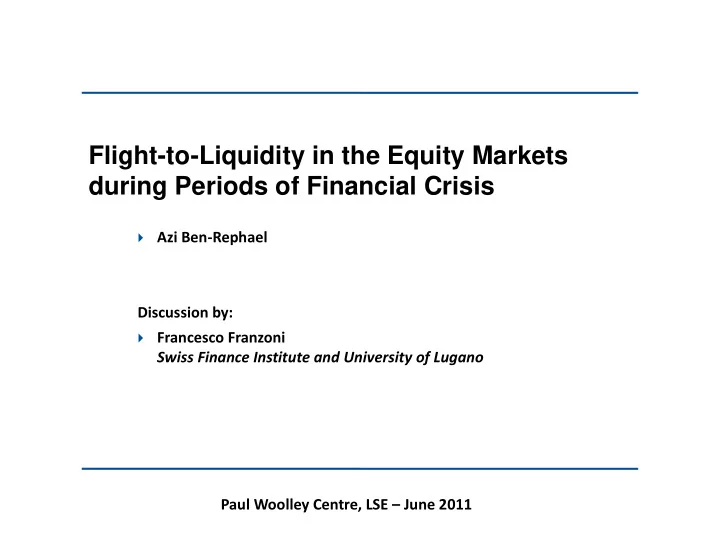

Flight-to-Liquidity in the Equity Markets during Periods of Financial Crisis Azi Ben ‐ Rephael Discussion by: Francesco Franzoni Swiss Finance Institute and University of Lugano Paul Woolley Centre, LSE – June 2011
The questions • Flight ‐ to ‐ liquidity (FTL) is postulated in theoretical models and there is consistent anecdotal evidence • Focus on “financial crises” • What is the impact on stock returns of FTL? • Which investor class is driving the FTL? • What are these investors’ motives for trade?
Results: return difference liquid vs. illiquid stocks • 3 months after the crisis start, (illiquid – liquid) portfolio has significant alpha = ‐ 2% • The return difference reverts in the next 3 months • Cumulative returns for the (illiquid – liquid) portfolio over the 100 following the crisis:
Results: mutual fund sales • Mutual funds, as a group, sell more illiquid stocks during financial crises • Other institutions absorb mutual fund sales • So, price patterns of liquid vs. illiquid stocks seem to result from price pressure due to mutual fund sales
Results: redemptions from illiquid funds • Do mutual funds strategically reallocate portfolios towards more liquid stocks (flight ‐ to ‐ liquidity)? • NO! • Investors redeem shares in funds that invest in more illiquid stocks • Possibly following poor returns by these funds • Only these funds dump illiquid stocks in the market • The reference to theoretical results on FTL (e.g. Vayanos 2004, Brunnermeier and Pedersen 2009) is not appropriate given the evidence
Comment: originality of results? • This paper combines two known results: Coval and Stafford (2007): fire sales by mutual funds generate price pressure + Amihud (2002): the price of illiquid stocks drops more when liquidity deteriorates in the market (almost by definition of illiquidity) • So, I read this part of the paper as a cross ‐ sectional extension of Coval and Stafford (2007)
Comment: real contribution of the paper • The truly original finding, in my view, is the run on illiquid mutual funds’ assets • Why do investors do it? • May want to disentangle two stories: 1. Illiquid funds are more likely to suffer in bad � mes → Investors react to poor returns of these funds 2. Investors try to be the first to get out, anticipating a run ‐ for ‐ the ‐ exit (as in a bank run), exacerbated by asset illiquidity • Regress fund flows on asset illiquidity, controlling for past returns
Comment: 10 financial crises? • The paper defines financial crises as the 10 highest monthly changes in the VIX so far • This de fi ni � on has hindsight bias → the alphas are not generated by a replicable trading strategy • 10 “financial crises” in 25 years is a bit too many, even for dysfunctional markets • There’s a risk of adding Apples and Oranges • Focus on the last (true) financial crisis • Or, like in Coval and Stafford (2007), identify mutual funds in distress and focus on their sales patterns
Ben-David, Franzoni, Moussawi (2011) • Major stock selloffs by Hedge Funds during last crisis • Mostly due to redemptions and forced deleveraging Lehman Collapse Quant Meltdown 3.5 September 2008 August 2007 % of total market capitalization 3 2.5 2 1.5 1 2 3 4 1 2 3 4 1 2 3 4 1 2 3 4 1 2 3 4 1 2 3 4 q q q q q q q q q q q q q q q q q q q q q q q q 4 4 4 4 5 5 5 5 6 6 6 6 7 7 7 7 8 8 8 8 9 9 9 9 0 0 0 0 0 0 0 0 0 0 0 0 0 0 0 0 0 0 0 0 0 0 0 0 0 0 0 0 0 0 0 0 0 0 0 0 0 0 0 0 0 0 0 0 0 0 0 0 2 2 2 2 2 2 2 2 2 2 2 2 2 2 2 2 2 2 2 2 2 2 2 2 Quarter
Our results • Unlike this paper, we find that hedge funds sell the liquid stocks first In a fire sale, they want to manage price impact It is also more difficult to sell illiquid assets at the peak of a crisis • Like this paper, we find that illiquid hedge funds (those with share restrictions) suffer from more redemptions Investors want to avoid being locked in when the fund raises gates • Question: source of different sale patterns between Hedge and Mutual funds during crisis?
HFs vs. MFs during the last crisis Hedge funds Flows/AUM (%) Trades/Total equity portfolio (%) Quarterly returns (%) 2007Q3 1.83 -9.87 -0.88 2007Q4 -2.34 -2.74 1.64 2008Q1 -0.56 4.72 -1.91 2008Q2 1.11 3.57 2.85 2008Q3 -0.94 -16.70 -7.69 2008Q4 -11.19 -14.26 -7.36 2009Q1 -14.93 13.88 0.59 Mutual Funds Flows/AUM (%) Trades/Total equity portfolio (%) Quarterly returns (%) 2007Q3 0.79 0.83 1.86 2007Q4 0.46 1.36 -2.39 2008Q1 0.08 -0.04 -8.90 2008Q2 0.79 -4.89 0.15 2008Q3 0.59 -0.12 -11.12 2008Q4 -0.92 -0.24 -22.13 2009Q1 -0.92 1.87 -7.97 • Hedge funds relative to equity mutual funds had: Higher redemptions Higher stocks sales as a fraction of portfolio • Conjecture: when it comes to selling a big chunk of the portfolio the cheapest way is to sell the liquid assets first
Conclusion • The paper highlights an interesting new fact: Investors’ run on illiquid mutual funds during a crisis • I would refocus the paper around this fact • Investigate the triggers of this behavior • Contrast with other institutions, e.g. Hedge Funds
Recommend
More recommend